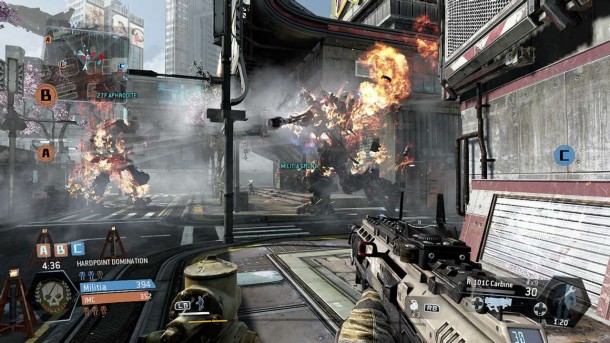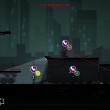[Other Take] Titanfall Review – Through the Eyes of a Lapsed Combatant
I grew up playing competitive shooters like Quake and Unreal Tournament, but these days, it's rare that an arena-based first-person shooter holds my interest, as evidenced by the fact that I've failed to connect with one since my tenure on the battlefields of Halo 3. I've looked for new suitors, but my efforts to reenter the fold with military-gilded games like Call of Duty: Modern Warfare 3 and Battlefield 3 never lasted more than a couple of hours at best. I thought they were good on their own terms, but they didn't deliver significantly different experiences from other games I'd played in the past. I came close to reconnecting with the genre in 2012, when I thought I'd found a shiny new friend in Tribes: Ascend, but I was let down by maps that didn't capitalize on Ascend's style of movement; they simply made room for it. With Titanfall's promise of parkour-inspired mobility mixed with intense man-on-mech combat, I was hopeful I had finally spotted my boat back to shore. It was another military shooter, but one set in a futuristic conflict with massive mechs that I could interact with by leaping into and out of the cockpit as I pleased. If any shooter was to appeal to my tastes, this was the one.
The transition back into the world of competitive shooters wasn't easy. At first, I felt that I was unfairly at the mercy of other players because I couldn't grasp exactly how they were spotting and killing me. After several rounds and educational deaths, I knew why: I was looking at Titanfall through old lenses. Unlike in other shooters, gravity is much less of a hindrance when you have a propulsive jump kit that allows you to run on walls and double jump onto the top of buildings. While I was busy running on the ground, peering around corners, my opponents were leaping off of billboards, scaling buildings, and hanging on walls above doorways, handily shooting me when my back was turned. Before I learned the importance and nuance of using every inch of the environment, I was a sitting duck. A brief tutorial introduces the concepts of wall-running, double-jumping, and piloting a titan, which is useful from a mechanical perspective, but it only taught me what I was capable of. When it came to learning how to survive against other players, there was no better classroom than the battlefield.
Thankfully, there were a few tools that gave me some much needed aid, including the smart pistol, which I quickly learned could be my best friend during a difficult match. This handy weapon lets you lock onto multiple targets if they spend enough time in the pistol's generously sized reticle, subsequently delivering lethal hits to ground troops. Once I got the hang of it, I was able to spend more time learning the ropes of movement and less time worrying about precision aiming at the start. Eventually, however, the smart pistol began to feel like a crutch that was limiting my potential. Given the time it takes for the smart pistol to lock on to enemies, I would eventually have to switch to less-forgiving but faster-firing weapons in order to remain competitive, and that would require target practice. Luckily, most modes incorporate simple, AI-controlled enemies, which are an easy source of experience points and target practice, allowing me to unlock more powerful weapons and bolster my proficiency with traditional guns.
Titanfall also incorporates temporary upgrades known as burn cards, which grant power-ups that can give you an edge beyond your current abilities. Burn cards affect weapons, skills, and cooldown timers for both pilots and titans, and they're doled out steadily at the end of each round, but since you're working with limited inventory space, it's best to use them as often as possible. Learning which burn cards are best suited for your style of play is important from a strategic standpoint, as they allow you to access weapons and powers that may lie five or ten levels ahead of your current rank.
It was another military shooter, but one set in a futuristic military conflict that put mechs front and center. If any shooter was to appeal to my tastes, this was the one.
Despite having to learn a few new systems, most of the competitive modes are immediately familiar: you vie for enemy flags in Capture the Flag, you claim and protect disparate strongholds in Hardpoint Domination, and in both Attrition and Pilot Hunter battles, your only goal is to kill your opponents. Both titans and pilots are targets in Attrition mode, but Pilot Hunter only rewards pilot kills, which significantly alters the importance of titans in battle, making them more of a means of defense than offense. Alternatively, Last Titan Standing pits teams of titans against one another over the course of four rounds. Fall in the middle of battle, and you're stuck on the sidelines until the next round.
Attrition is by far the most exciting mode of the lot. The mix of titans and pilots is thrilling and chaotic, and though pilots are dwarfed by titans, their agility should not be underestimated. In the right hands, a pilot's jump kit can be advantageous during close-range combat, allowing them to mount a titan (referred to as rodeoing) and attack its most vulnerable spot, potentially destroying it and forcing the pilot to expose himself during ejection. Sometimes this occurs when two titans are in a face-off and a pilot slips in unnoticed. Less aggressive pilots may do well to use their heavy anti-titan weapons from the safety of distant cover if they've grown too familiar with the underside of a titan's foot, however.
Marksmanship is an invaluable skill, but Titanfall elevates the importance of environmental awareness, and this shift enables a new type of player to succeed and revel in the competitive arena. The entire world is your sidewalk as a pilot, but it takes an experienced eye to recognize the subtle paths that run through the ruined cities, buckled space structures, and massive, derelict airships. You can brute-force your way across a map, but these environments are waiting to be exploited by fleet-footed and keen-eyed soldiers. Experienced players have a small advantage, but years of aiming down sights and understanding traditional maps can't prepare you for wall-running combatants with invisibility cloaks. It's important to keep moving, because your opponents are just as likely to come from above as they are from your side.
Jumping into a titan introduces a whole other series of lessons, since you can no longer leap off of walls and onto the tops of buildings like a pilot can. Unless you're playing the Last Titan Standing mode, titans become available after the first few minutes of a match. You can summon them immediately to your side if you're in an open area, or the game will automatically choose the closest locations with proper clearance for you.
Although you can order your titan to follow you on foot or roam freely, you'll undoubtedly spend a lot of time in the cockpit. Titans control like massive soldiers without jump kits, but they can still be relatively nimble when they need to be. Rather than solely marching with a heavy foot, titans are capable of dashing in short bursts to avoid fire and pop into or out of cover, and different classes mix up the ratio of speed and armor to suit different play styles. Titans also possess extreme abilities--like the vortex shield that lets you catch and return enemy fire--which make for explosive and riveting exchanges between enemy titans.
Once I'd grasped the extent of my new abilities, which took a few hours, Titanfall became everything I'd hoped it would be. Fighting on foot as a pilot with the ability to run along walls and leap into second-story windows felt liberating, and when the mammoth titans came into play, I was David or Goliath depending on the moment, and each perspective came with its own sense of empowerment. Titanfall delivers a compelling competitive experience by mixing these two types of units on the battlefield, culminating in explosive and chaotic matches unlike anything I've experienced before.
The only thing missing is a rich single-player campaign. It simply doesn't exist. Titanfall is a pure multiplayer experience, and while it excels in that regard, it fails to form a meaningful link between you and its world. There's a story that provides the necessary context for a military conflict, where two human factions vie for resources and territory, but the events that take place during the online-only campaign are largely meaningless. You have no identity, there's no source of emotional inspiration, and the sole motivation for playing the campaign--twice--is for the new titan chassis that unlock at the end. These add a little variety to your titan loadout options, but it's not so great a prize as to justify forcing you to play through vapid and paltry narrative trappings.
Campaign issues aside, Titanfall's expert mix of light-footed pilots and massive Titans brings something entirely new to the competitive arena. These systems mesh perfectly with existing shooter tropes, and the combination of new and old has reinvigorated my interest in a type of game I had all but written off. If getting back into shooters after Halo 3 was challenging for me, I can only imagine how hard it will be to find a game that can live up to the new standards set by Titanfall.
Peter hasn't found a competitive shooter that he's truly liked since Halo 3, and was delighted enough with Titanfall's gameplay that he played around 20 hours between the PC, Xbox One, and Xbox 360 versions before writing his review.








